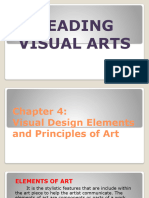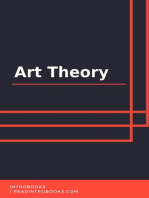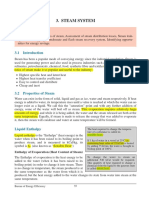0 ratings0% found this document useful (0 votes)
26 viewsVisual Arts
Visual Arts
Uploaded by
kkkThe document discusses the elements and principles of visual art. It defines elements as the basic components of an artwork that can be directly observed, such as line, shape, form, color, texture, space and value. It defines principles as the rules that artists follow or defy, such as how curved lines convey movement or the use of complementary colors. The document then examines each element in more detail and provides examples of how artists incorporate and manipulate the elements using underlying principles.
Copyright:
© All Rights Reserved
Available Formats
Download as PDF, TXT or read online from Scribd
Visual Arts
Visual Arts
Uploaded by
kkk0 ratings0% found this document useful (0 votes)
26 views18 pagesThe document discusses the elements and principles of visual art. It defines elements as the basic components of an artwork that can be directly observed, such as line, shape, form, color, texture, space and value. It defines principles as the rules that artists follow or defy, such as how curved lines convey movement or the use of complementary colors. The document then examines each element in more detail and provides examples of how artists incorporate and manipulate the elements using underlying principles.
Copyright
© © All Rights Reserved
Available Formats
PDF, TXT or read online from Scribd
Share this document
Did you find this document useful?
Is this content inappropriate?
The document discusses the elements and principles of visual art. It defines elements as the basic components of an artwork that can be directly observed, such as line, shape, form, color, texture, space and value. It defines principles as the rules that artists follow or defy, such as how curved lines convey movement or the use of complementary colors. The document then examines each element in more detail and provides examples of how artists incorporate and manipulate the elements using underlying principles.
Copyright:
© All Rights Reserved
Available Formats
Download as PDF, TXT or read online from Scribd
Download as pdf or txt
0 ratings0% found this document useful (0 votes)
26 views18 pagesVisual Arts
Visual Arts
Uploaded by
kkkThe document discusses the elements and principles of visual art. It defines elements as the basic components of an artwork that can be directly observed, such as line, shape, form, color, texture, space and value. It defines principles as the rules that artists follow or defy, such as how curved lines convey movement or the use of complementary colors. The document then examines each element in more detail and provides examples of how artists incorporate and manipulate the elements using underlying principles.
Copyright:
© All Rights Reserved
Available Formats
Download as PDF, TXT or read online from Scribd
Download as pdf or txt
You are on page 1of 18
Intended Learning Outcomes:
• Define elements and principles of art;
• Identify the elements of visual arts;
• Recognize the principles of visual arts, and
• Exhibit the elements and principles of
visual arts.
Elements vs. Principles
When we talk about elements, we are
talking of the basic components that make
up the artwork. Elements are observable
parts of the artwork, particularly with visual
arts, which are directly seen by the eyes or
directly felt by the sense of touch.
Elements vs. Principles
On the other hand, the principles are the
rules that the artist follow or defy from.
Principles cannot be seen immediately,
rather have to be reflected upon, because
these are decisions that the artist has made
so s/he could achieve what is ought to be
exhibited or portrayed in the work.
Elements vs. Principles
Take the artwork above as an example—The Great Wave of Kanagawa by
Katsushika Hokusai. One element we could pick out from this whole image is the
lines that make the wave. However, the lines are curved, in which, by principle,
means change and fluidity. This is the reason why the artist incorporated the line
element and at the same time chose to have the lines curved so he could portray
rightfully the nature of the wave.
The Visual Art Elements
and their Underlying
Principles
Element #1: Line
Lines are used to control where they eyes
will lead and focus, or are used to delineate
shapes and indicate texture whether it is
rough, smooth, thin or thick. Lines are
important because they indicate
movements and directions.
Element #1: Line
• Horizontal line- expresses serenity, rest, stability in
general
• Vertical line- implies growth, authority,
confidence and poise
• Diagonal line- growth, pursuit, persistence,
dynamism
• Curved line- connotes change, direction,
movement, femininity, uncertainty, grace
• Jagged line- expresses erraticism, anxiety,
turmoil, inconsistency
Element #2: Shape
Shapes are two-dimensional, flat elements that
are generally enclosed spaces. Shapes in art
can be used to control how the viewer
perceives a piece. There are two major
classifications of shape which are the organic
and the geometric shapes.
Organic shapes are those with a natural look
and a flowing and curving appearance.
Geometric shapes are circles, rectangles,
squares, triangles and so on, that have the clear
edges one achieves when using tools to create
them.
Element #3: Form
Form connotes something that is three-
dimensional and encloses volume, having
length, width, and height, versus shape, which is
two-dimensional, or flat. A form is a shape in
three dimensions, and, like shapes, can be
geometric or organic.
Element #4: Color
Color is the element of art that involves light. It is
produced when light waves strike an object and
are reflected into our eyes. It consists of three
properties: hue, intensity, and value.
• Hue simply refers to the name that is
given to a color, such as red, yellow, blue,
purple, green, orange, etc.
• Intensity (or saturation) refers to the purity
or dullness of a color.
• Value is the lightness or darkness of a
color
Element #4: Color
The color wheel (sometimes called a color
circle) is a handy tool often used by artists and
interior decorators as a visual aid in
understanding the relationship between colors.
The color wheel is a circular chart divided into 12
sections with each sector showing a different
color. It is made up of three different types of
colors – primary, secondary, and tertiary.
Element #4: Color
Primary colors are red, yellow, and blue. These
colors are equally distanced apart on the color
wheel. There only three primary colors and they
are the most basic colors on the wheel. They
cannot be created by mixing any other colors
together and can only be derived through
natural pigments.
Element #4: Color
Secondary colors are orange, green and purple
(or violet). These colors are created from mixing
equal parts of any two primary colors together.
Tertiary colors are red-purple, red-orange, blue-
green, blue-purple, yellow-green, and yellow-
orange. There are six tertiary colors and they are
the result from mixing equal parts of a primary
color with a secondary color. The proper way to
refer to tertiary colors is by listing the primary
color first and then the secondary color. That’s
why tertiary colors are referred to by a two word
name.
Element #5: Texture
Texture refers to the surface quality in a work of
art. We associate textures with the way that
things look or feel. Everything has some type of
texture. We describe things as being rough,
smooth, silky, shiny, fuzzy and so on.
Texture is experienced in two ways — with
touch (tactile) and with our eyes (visually).
Element #6: Space
Space refers to the distance between or the
area around and within shapes, forms, colors
and lines. Space can be positive or negative. It
includes the background, foreground and
middle ground.
There are two types of space that exist within art
— positive space and negative space. Positive
space is the actual objects or shapes within an
artwork and negative space is the space
around and between those objects.
Element #7: Value
Value is a basic element of art that refers to the
gradual change of lightness or darkness of a
color. It is created when a light source shines
upon an object creating highlights, form
shadows and cast shadows.
Colors can have value too. In painting, value
changes can be achieved by adding either
black or white to the chosen color. Some colors,
like yellow and orange, are naturally light in
value.
You might also like
- Importance of Time Management For StudentsDocument2 pagesImportance of Time Management For StudentsHaripriya V100% (1)
- The Elements of Visual Arts.. DenmarkDocument18 pagesThe Elements of Visual Arts.. DenmarkKiru Shiku100% (1)
- MR Right - Case Study Test - Summer 2018Document7 pagesMR Right - Case Study Test - Summer 2018jadenNo ratings yet
- ENG 102: Art Appreciation: Module 5: Elements and Principles of Visual ArtsDocument6 pagesENG 102: Art Appreciation: Module 5: Elements and Principles of Visual ArtsMianira MigoNo ratings yet
- Art-App-Module-5-Elements-and-Principles-of-Visual-Arts-and-Mediums-and-Techniques-of-Painting NotesDocument19 pagesArt-App-Module-5-Elements-and-Principles-of-Visual-Arts-and-Mediums-and-Techniques-of-Painting Notesssamyang92No ratings yet
- Art App Module 5B Elements and Principles of Visual Arts and Mediums and TechniquesDocument24 pagesArt App Module 5B Elements and Principles of Visual Arts and Mediums and TechniquesEvrylle JariolNo ratings yet
- IEPDA-Module-1-Rodriguez ME Week-1Document18 pagesIEPDA-Module-1-Rodriguez ME Week-1Maria RodriguezNo ratings yet
- Minding The Arts (By Leynes & Fajardo PDFDocument236 pagesMinding The Arts (By Leynes & Fajardo PDFPrincess Gloriani0% (1)
- Elements of Art Principles of Design Art Criticism - HandoutDocument4 pagesElements of Art Principles of Design Art Criticism - Handoutapi-294607284No ratings yet
- Elements and Principles of ArtDocument49 pagesElements and Principles of Artgiezxc99No ratings yet
- Aesthetic PerceptionDocument16 pagesAesthetic PerceptionHELMSELLE JISONNo ratings yet
- The Elements of Art and Principles of DesignDocument5 pagesThe Elements of Art and Principles of DesignDE CASTRO, Xyra Kate D.No ratings yet
- Elements of Visual ArtsDocument21 pagesElements of Visual ArtsAlthea Aubrey AgbayaniNo ratings yet
- AED 3 ReviewerDocument20 pagesAED 3 ReviewerFABM-B JASTINE KEITH BALLADONo ratings yet
- MAPEH Grade 9 Arts of The Renaissance Period ReviewerDocument51 pagesMAPEH Grade 9 Arts of The Renaissance Period ReviewerjklovrvNo ratings yet
- Art Appreciation Lesson 2 Elements and Principles of ArtDocument52 pagesArt Appreciation Lesson 2 Elements and Principles of ArtbernaldcatliNo ratings yet
- Module 6 Art AppreciationDocument7 pagesModule 6 Art AppreciationJan Jerwin PobleteNo ratings yet
- S3 IpsDocument31 pagesS3 IpsWilberforceNo ratings yet
- Spa-Visual Arts W2Document11 pagesSpa-Visual Arts W2Lorry LeeNo ratings yet
- Elements of ArtDocument11 pagesElements of Artsquadb744No ratings yet
- Humanities Module 4Document6 pagesHumanities Module 4Shey MendozaNo ratings yet
- Hum 01 UNIT 5 Lessons 12 and 3Document17 pagesHum 01 UNIT 5 Lessons 12 and 3Bj Apostol QuejaNo ratings yet
- Rva 4Document33 pagesRva 4Jacob Andrew DuronNo ratings yet
- Chapter 1 6 Arts ReviewerDocument11 pagesChapter 1 6 Arts ReviewerMiranda, Luzviminda M.No ratings yet
- Chapter-2-3-Elements-and-Principles-of-Art (1)Document41 pagesChapter-2-3-Elements-and-Principles-of-Art (1)pusonleanne028No ratings yet
- Q1arts10module1 221210131238 21e253e0Document73 pagesQ1arts10module1 221210131238 21e253e0Angelica RocamoraNo ratings yet
- The Elements and Principles of ArtDocument13 pagesThe Elements and Principles of ArtADEDAYO JEREMIAH ADEYEKUNNo ratings yet
- 11 Painting - Fundamentals of Visual Art - Notes and Video LinkDocument4 pages11 Painting - Fundamentals of Visual Art - Notes and Video Linksneha0% (1)
- Elements of Beauty and UniquenessDocument18 pagesElements of Beauty and Uniquenessmaria kyla andradeNo ratings yet
- HSM 453 Interior DecorationDocument6 pagesHSM 453 Interior DecorationjoyoluomaomekeNo ratings yet
- The Elements of ArtDocument7 pagesThe Elements of ArtTitus NoxiusNo ratings yet
- Composition and ElementsDocument32 pagesComposition and ElementssnehaNo ratings yet
- Elements of Art_CPAR 12 Q1_L1_24_25Document79 pagesElements of Art_CPAR 12 Q1_L1_24_25Lari PaintsNo ratings yet
- Art App Module 5 Elements and Principles of Visual Arts and Mediums and TechniquesDocument52 pagesArt App Module 5 Elements and Principles of Visual Arts and Mediums and TechniquesEvrylle JariolNo ratings yet
- Elements of Visual ArtsDocument19 pagesElements of Visual ArtsNew Taugtog Elementary School II (Region III - Zambales)No ratings yet
- The Elements of ArtDocument7 pagesThe Elements of ArtAeleu JoverzNo ratings yet
- Lesson_1_Elements_and_principle_of_designDocument43 pagesLesson_1_Elements_and_principle_of_designvillasantaleiNo ratings yet
- Art App - Minding The ArtsDocument236 pagesArt App - Minding The ArtsMikee Brobio San Miguel67% (3)
- Elements of Interior DesignDocument17 pagesElements of Interior DesignIrshad AhmedNo ratings yet
- Lesson 4-Elements of ArtsDocument41 pagesLesson 4-Elements of ArtsJessa Mae BasaNo ratings yet
- Arts Lesson 1Document45 pagesArts Lesson 1michelle.balenaNo ratings yet
- Elements of ArtDocument32 pagesElements of Artjadygordon6No ratings yet
- Arts 7Document30 pagesArts 7ivan tagiobonNo ratings yet
- Elements of Visual ArtDocument36 pagesElements of Visual ArtJefferson LoloNo ratings yet
- Elements AND Principles of ArtDocument13 pagesElements AND Principles of ArtwaterbottleNo ratings yet
- LP ArtsDocument71 pagesLP ArtsJirah Hope Zulueta DullaNo ratings yet
- UntitledDocument19 pagesUntitledJuliane keith MartinNo ratings yet
- Videography NC IIDocument117 pagesVideography NC IIAlmir BatacNo ratings yet
- Elements and Principles of ArtDocument55 pagesElements and Principles of ArtFelipe Glenn AmoyanNo ratings yet
- Art AppDocument23 pagesArt AppAbdulnasser Nanding Jr.No ratings yet
- Lecture 5Document16 pagesLecture 5tariqshah457No ratings yet
- Unit Elements PrinciplesDocument11 pagesUnit Elements PrinciplesChetna Shetty DikkarNo ratings yet
- Gec 6 Unit 4Document28 pagesGec 6 Unit 4ladyannurotNo ratings yet
- Topic 4Document9 pagesTopic 4angelomark2415No ratings yet
- Met Arts ManilaDocument242 pagesMet Arts ManilaMaria Eloisa Junelle O. NacawiliNo ratings yet
- Elements of ArtDocument8 pagesElements of ArtCharm SzamNo ratings yet
- Week 4-5 - Lesson 3 - Elements of Visual Art - PresentationDocument38 pagesWeek 4-5 - Lesson 3 - Elements of Visual Art - PresentationShaneNo ratings yet
- Visual Art Topic 3: Visual Analysis and Interpretation: Kristie Domenique Beukes 201202418 Pfs3ADocument25 pagesVisual Art Topic 3: Visual Analysis and Interpretation: Kristie Domenique Beukes 201202418 Pfs3AAnalyn QueroNo ratings yet
- GRD 7 Visual Art T1 2018 Edit ApprovedDocument20 pagesGRD 7 Visual Art T1 2018 Edit ApprovedsalamanyalegenyaNo ratings yet
- Elements of Art - Mastering the Building Blocks of Artistic CreationFrom EverandElements of Art - Mastering the Building Blocks of Artistic CreationNo ratings yet
- Lesson 1 Defining Arts (Assumptions, Scope, and Limitation) - FinalDocument17 pagesLesson 1 Defining Arts (Assumptions, Scope, and Limitation) - FinalkkkNo ratings yet
- Mediums and Techniques (Painting)Document29 pagesMediums and Techniques (Painting)kkkNo ratings yet
- Lec-1-History & What Is Civil Engineering - CEO-111Document57 pagesLec-1-History & What Is Civil Engineering - CEO-111kkkNo ratings yet
- 2021 CE111 Lecture 4Document9 pages2021 CE111 Lecture 4kkkNo ratings yet
- Format ShortDocument6 pagesFormat Shortjaja riveraNo ratings yet
- Lenchen's House PVsyst - VC0-ReportDocument7 pagesLenchen's House PVsyst - VC0-ReportBilly JhunNo ratings yet
- A Simple Method For The Calibration of An Open Surface Water BathDocument6 pagesA Simple Method For The Calibration of An Open Surface Water BathJEOVADJNo ratings yet
- Cell Structure Function Worksheet With HintsDocument7 pagesCell Structure Function Worksheet With Hintsapi-249772989No ratings yet
- Materials 17 04159Document18 pagesMaterials 17 04159carloscaparrosinhaNo ratings yet
- Triassic PG2003Document11 pagesTriassic PG2003Sabrina TorchiaNo ratings yet
- Mathcad - Wall Anchors CheckDocument2 pagesMathcad - Wall Anchors Checkneil gonzalesNo ratings yet
- ANCS AF2 4th QuarterDocument70 pagesANCS AF2 4th Quartereddie fernandezNo ratings yet
- CCBP 2020 03march LRDocument36 pagesCCBP 2020 03march LRJuan BarrientosNo ratings yet
- 07 - Bahala Na PDFDocument6 pages07 - Bahala Na PDFPrincess Janisah MagondacanNo ratings yet
- BEE Steam V Useful - 2Ch3 PDFDocument34 pagesBEE Steam V Useful - 2Ch3 PDFArnav KothiyalNo ratings yet
- Writing Lab Reports - UNAMDocument9 pagesWriting Lab Reports - UNAMwedzeNo ratings yet
- Anchoring PhraseDocument2 pagesAnchoring PhraseDhivya SanthoshNo ratings yet
- Elex DC Cir 2Document2 pagesElex DC Cir 2Jaiko BendoNo ratings yet
- Plane Coordinate Projection Tables Georgia: S. Department CommerceDocument21 pagesPlane Coordinate Projection Tables Georgia: S. Department Commercepogopogo22No ratings yet
- The Problem With PlasticDocument2 pagesThe Problem With PlasticaafiabashaNo ratings yet
- BRM Unit 3Document42 pagesBRM Unit 3prem nathNo ratings yet
- The Encyclopedia of Origami and Papercraft Techniques - 1st Edition (1995)Document258 pagesThe Encyclopedia of Origami and Papercraft Techniques - 1st Edition (1995)sahary 12100% (1)
- Assessment Form - Applicant MayonteDocument1 pageAssessment Form - Applicant MayonteAlbertJohnOliveraNo ratings yet
- sabakDocument3 pagessabakkhainnn24No ratings yet
- Sheeba Preethi. A: Profile SummaryDocument2 pagesSheeba Preethi. A: Profile SummaryShaffeeNo ratings yet
- PPSA Year 3 EnglishDocument15 pagesPPSA Year 3 EnglishAnis FaisalNo ratings yet
- Effective Office CommunicationDocument41 pagesEffective Office CommunicationMaurya VermaNo ratings yet
- New Age Life Skill pdf2Document33 pagesNew Age Life Skill pdf2Rachit KhuranaNo ratings yet
- Studying The Migration-Security Nexus' in Europe: Towards Which End of The Nexus'?Document28 pagesStudying The Migration-Security Nexus' in Europe: Towards Which End of The Nexus'?Fiorenza PicozzaNo ratings yet
- Scientific Notation Review 0-40 PDFDocument3 pagesScientific Notation Review 0-40 PDFcirli bauNo ratings yet
- Fazal Islam Most Updated CV March 2024 For FBISEDocument2 pagesFazal Islam Most Updated CV March 2024 For FBISECreative MindNo ratings yet
- ABSTRACTDocument3 pagesABSTRACTJEEVA P GNo ratings yet





























































































